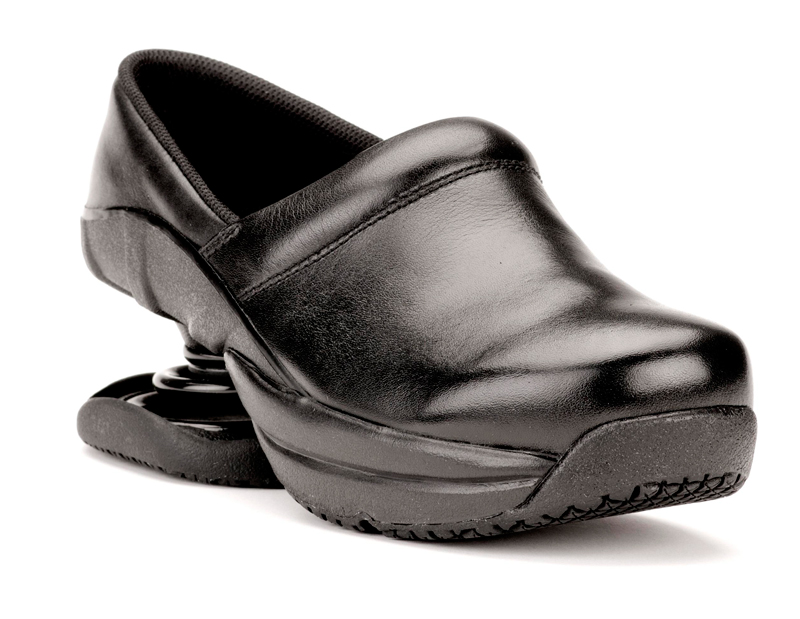The Z-CoiL
The Spring
The Z-CoiL Spring makes each step safer and softer. The unique replaceable conical coil design reduces impact up to 60%* more than conventional shoes. And since impact is the primary cause of foot, leg and back pain, your body will notice an immediate difference. Walking in Z-CoiL is unlike anything you have felt before. Some people describe the feeling like gliding. Each step feels easy, light and enjoyable.
Your body will love the Z-CoiL Spring. Not only does the Z-CoiL Spring reduce impact, it can control over-pronation. Over-Pronation is when your feet roll too far inward when walking or running. The spring can be adjusted in 90°increments to add more resistance to the inside of the foot, to correct over-pronation. Last but not least, when the rubber heel pad wears out on the spring, you can simply replace the spring unit (open or enclosed) rather than replace your Z-CoiL! This saves money and reduces unnecessary waste in landfills.
The Z Solution
Z-CoiL Pain Relief Footwear is the only shoe that offers both the impact reduction and stability you need for pain relief, injury prevention and whole body support Z-CoiL shoes have the:
- Patented conical spring in the heel, which reduces impact by 40-60% (according to tests performed by the American Department of Energy) and provides energy return, reducing fatigue.
- Patented Z-Orthotic™ to stabilize tendons and ligaments.
- Rocker bottom sole that assists forward motion and limits movement during toe-off.
- Flex line at the forefront of the foot to encourage bending at the ball of the foot.
- 3/4" Cushioning in the forefoot to protect delicate metatarsal/forefoot joints, ligaments and bones.
- Extra wide toe box to relieve pressure on toe joints.
- All elements of our shoe design provide Z-CoiL treatment—effective pain relief from a number of lower body impact-induced conditions.
The Z Breakdown
Gait Cycle and the Kinetic Chain
Humans propel themselves through the concrete jungle the same way they have for thousands of years: heel strike → full forefoot load → heel lift → toe off. During a normal gait cycle, your heel makes contact and immediately redistributes the force—twice your body weight on each foot—up along the side of your foot, the part of your foot designed to actually absorb impact and transfer energy to continue forward motion. However, not all impact is transferred up your foot. Much energy is transferred along what chiropractors call the kinetic chain: heels → ankles → shins → knees → thighs → hips → pelvic girdle/lower back.
Unlike the environments our ancestors walked, today's concrete and other hard surfaces are much less forgiving, resulting in significantly more stress to the body. Every day we experience thousands of collisions with the ground. The greater impact delivered up the kinetic chain, sometimes exacerbated by an improper gait cycle (over-pronation or supination), compromise the human body's ability to absorb and redistribute stress forces, causing injuries.
Impact Reduction, Stability and the Problem with Modern Footwear
Preventing stress injury and providing relief for existing injuries requires impact reduction—i.e., footwear that actually limits the amount of force that travels up the kinetic chain. However, cushioning impact alone will not ensure healthy joints and pain relief. Shoes that offer extra padding actually encourage atrophy in the muscles of the foot. Weak muscles can lead to a number of compensating movements, many of which direct stress forces to areas of the foot that are not designed to absorb impact. Unfortunately, most modern footwear has taken an either-or approach to solving the problem of increased impact along the kinetic chain. Either they provide cushiony soles to reduce the force of impact but allow the flexibility for soft tissues to move outside a normal range of motion, or they provide a rigid sole to keep the foot (and stress forces) in a natural range of motion but with very little impact-absorption, resulting in high impact all the way up the kinetic chain.
This model may be fully covered by insurance with a doctors referral.
It may be partially covered by insurance if referred by a specialist.

